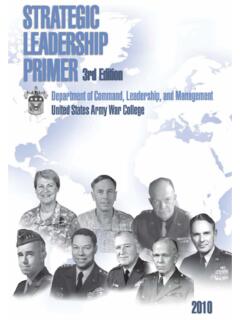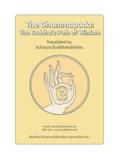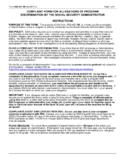Transcription of SOLDIERS IN CITIES: MILITARY OPERATIONS ON URBAN …
1 SOLDIERS IN CITIES: MILITARY OPERATIONS . ON URBAN TERRAIN. Edited by Michael C. Desch October 2001. **. The views expressed in this report are those of the authors and do not necessarily reflect the official policy or position of the Department of the Army, the Department of Defense, or the Government. This report is cleared for public release; distribution is unlimited. **. Comments pertaining to this report are invited and should be forwarded to: Director, Strategic Studies Institute, Army War College, 122 Forbes Ave., Carlisle, PA 17013-5244. Copies of this report may be obtained from the Publications and Production Office by calling commercial (717) 245-4133, FAX (717) 245-3820, or via the Internet at **.
2 Most 1993, 1994, and all later Strategic Studies Institute (SSI) monographs are available on the SSI Homepage for electronic dissemination. SSI's Homepage address is: mil/ **. The Strategic Studies Institute publishes a monthly e- mail newsletter to update the national security community on the research of our analysts, recent and forthcoming publications, and upcoming conferences sponsored by the Institute. Each newsletter also provides a strategic commentary by one of our research analysts. If you are interested in receiving this newsletter, please let us know by e- mail at or by calling (717) 245-3133. ISBN 1-58487-062-1. ii CONTENTS. Foreword .. v Preface .. vii Acknowledgments .. ix 1. Why MOUT Now? Michael C.
3 Desch .. 1. 2. Stalingad and Berlin: Fighting in URBAN Terrain Gerhard L. Weinberg .. 17. 3. MILITARY OPERATIONS in URBAN Environments: The Case of Lebanon, 1982. Dov Tamari .. 29. 4. Lessons of the War in Chechnya, 1994-96. Anatol Lieven .. 57. 5. The Battles of Saigon and Hue: Tet 1968. James J. Wirtz .. 75. 6. The Los Angeles Riots of 1992. James D. Delk .. 89. 7. Low-Intensity OPERATIONS in Northern Ireland David Pearson .. 103. 8. MILITARY OPERATIONS in an URBAN Environment: Beirut, 1982-84. Bernard E. Trainor.. 121. 9. Emerging Technologies and MILITARY OPERATIONS in URBAN Terrain Gerald Yonas and Timothy Moy .. 131. 10. URBAN OPERATIONS : Social Meaning, the URBAN Built Form, and Economic Function Max Neiman.
4 139. 11. URBAN OPERATIONS : Tactical Realities and Strategic Ambiguities Barry R. Posen .. 149. 12. About the Contributors .. 167. iii FOREWORD. This compendium is the result of a conference on MILITARY OPERATIONS in an URBAN Environment . cosponsored by the Patterson School of Diplomacy and International Commerce in conjunction with the Kentucky Commission on MILITARY Affairs, the Army War College, and the Association of the United States Army. At the time of the conference, the concept of homeland defense was emerging as an increasingly important mission for the MILITARY . Now this mission has catapulted to prominence with the attacks of September 11 and the appointment of a Director of Homeland Defense a Cabinet-level position.
5 The authors of the chapters examine the ongoing doctrinal thinking, draw historical comparisons, and discuss the thoughts of those attending the conference experts from the MILITARY , government civilian agencies, academia, think tanks, and the defense industry regarding unconventional warfare. Collectively, they provide a comprehensive report on critical factors that the MILITARY soon may face. The Strategic Studies Institute commends this collection to all who share a concern about MILITARY OPERATIONS in URBAN terrain. DOUGLAS C. LOVELACE, JR. Director Strategic Studies Institute v PREFACE. SOLDIERS in Cities is required reading for MILITARY professionals and others interested in defense policy and issues. In the past half-century, the classic MILITARY conflict of armies maneuvering in the field has been replaced by conflicts that center on, rather than avoid, heavily populated areas.
6 Modern MILITARY conflict more frequently is not just a fight to control villages or cities, but a variation on the timeless wish to control populations and the hearts of nations. The hardware and mass orientation of the lev e en masse and industrial-age armies is being replaced by sophisticated terrorists, information warfare, and the politics of mass persuasion. This is reshaping the face of warfare. America's own MILITARY history demonstrates the soldier's dilemma in fighting among populations. The Army's experience is extensive but often forgotten. First called on to defend settlements against Indian attacks, it later laid siege to or captured cities in Mexico and during the American Civil War. During World War II, the Army liberated or seized thousands of towns and hundreds of cities on the European continent.
7 Fighting in or around village hamlets or cities was a frequent occurrence in Southeast Asia OPERATIONS . Strangely, our doctrine and cultural focus have remained preoccupied with the classic fight in the woods or the seizure of high ground. URBAN OPERATIONS or OPERATIONS among a foreign populace were always considered possible but were not formally incorporated into regular annual training for most combat units. That trend is ending. The required change has been a long time coming. During the 1970s the classic defense issues of the European General Defense Plan became more and more affected by the URBAN sprawl that changed the face of Europe. As post-Cold War planners surveyed contingencies, it became apparent that the growing urbanization of man affected not just developed but also underdeveloped nations.
8 True maneuver possibilities sought by our technology-rich Army remained only in deserts. The emerging future would be different. The battlefield would most likely be a populated area. Modern MILITARY forces may vii fight sophisticated armies and air forces, but cities and populations will no longer be innocent bystanders. The complex terrain of URBAN centers will be critical in any modern operation, and their populations will become involved. Our national policy to promote, defend, and, if need be in some circumstances, install democracy demands a multitasked force that will provide stability and peace to populations in the battle area. As the armed forces become more involved in stability OPERATIONS , and with the increasing likelihood that possible opponents will seek shelter in URBAN areas, it is imperative that our SOLDIERS be skilled in a wide array of URBAN -centered OPERATIONS ranging from forced entry to peacekeeping.
9 As such, our armed forces must be expert in the tactics and techniques of URBAN OPERATIONS throughout the spectrum of peace and war missions. SOLDIERS in Cities clearly delineates the problems facing modern armed forces entering an URBAN environment. That we will enter that environment during future contingencies is a given. That we are ready to adapt our techniques, technology, and training to that day is a decision we have already made in the positive. The Association of the United States Army is proud to have been a co-sponsor of the conference that produced this fine work and confidently recommends it to defense professionals. General Gordon A. Sullivan Army (Retired). President Association of the Army viii ACKNOWLEDGMENTS.
10 This volume, and the conference that preceded it, were made possible through the participation and generosity of a number of individuals. Brigadier General (Retired) James Shane, the Executive Director of the Kentucky Commission on MILITARY Affairs, first conceived of the idea of a national symposium, provided much of the financial support for it, and played a key role in getting high-level Army officers to participate in it. Lieutenant General (Retired) Theodore Stroup of the Association of the Army assisted us both financially and in helping us secure high-level participation from the retired Army community. Lieutenant Colonel Lawrence Pappini of the Army War College also provided very important financial and logistical support.










